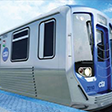The city council's financial analysis arm has estimated that a new transit taxing district can generate at least $5 billion in revenue—far more than had been previously claimed.
The area in question is part of the Chicago Transit Authority's Red Purple Modernization (RPM) project. RPM's first stage, Phase 1, involves new and rebuilt Red Line tracks, stations, and other rail facilities between Belmont and Ardmore Avenues.
The city has applied for a $625 million federal loan to help fund the project. To repay the loan, the city positioned the project inside of a tax-increment financing (TIF) district.
The TIF district, which will siphon property taxes away from government entities and into the rail project, was originally slated by officials to produce project-related revenue in an amount equal to the federal loan, or $625 million.
To repay the loan, however, the city would have to pay not only principle, but interest—a fact that officials downplayed in initial public disclosures about the TIF district required by law. Those disclosures included a CTA presentation at a Sept. 13 public meeting and a Sept. 20 redevelopment plan released by the city's planning department.
In a Nov. 28 meeting of the city council's finance committee, city officials revealed their estimate of the total cost of the loan: just over $823 million, which the city plans to pay off in 17 years. During that time, according to city figures, the TIF district would have accumulated about $851 million.
However, by state law, the TIF district could continue diverting property taxes for 35 years. According to a separate estimate created by Ben Winick, head of the Council Office of Financial Analysis, the TIF district is capable of producing at least $5 billion in transit-related revenue in those 35 years.
The growth in TIF revenue results from the presumed rising value of private property within the TIF district. As values increase, so do property taxes—and about 37 percent of the increased taxes will be diverted to the transit project.
In an interview, Winick said that his $5 billion estimate is a conservative one, for a couple of reasons.
First, Winick projected a very gradual growth in property values. "I used one and a half percent over the first few years," Winick said, "then 3.6 percent annually after that." That's a cautious projection, because the TIF district covers sought-after parts of the North Side: a mile-wide span along the Red Line from Division St. to Devon Ave.
Second, Winick used the county's 2015 tax rate of 6.867 percent in all 35 years—"which is probably a little low because it doesn't account for future [tax] increases," he said.
Winick said his assumptions differed slightly from those of the city's Office of Budget and Management—the latter having created, Winick said, the numbers presented to the city council's finance committee on Nov. 28. The budget office did not respond to a request for comment.
Although the ordinance enacting the transit TIF district contains language about aborting the district after its loan-related payments have been made, the language states only that the city "will use its best efforts to adopt an ordinance, within 120 days" to do so.
As Inside Chicago Government has reported previously, such language doesn't obligate the city to actually end the TIF diversion of taxpayers' money.






